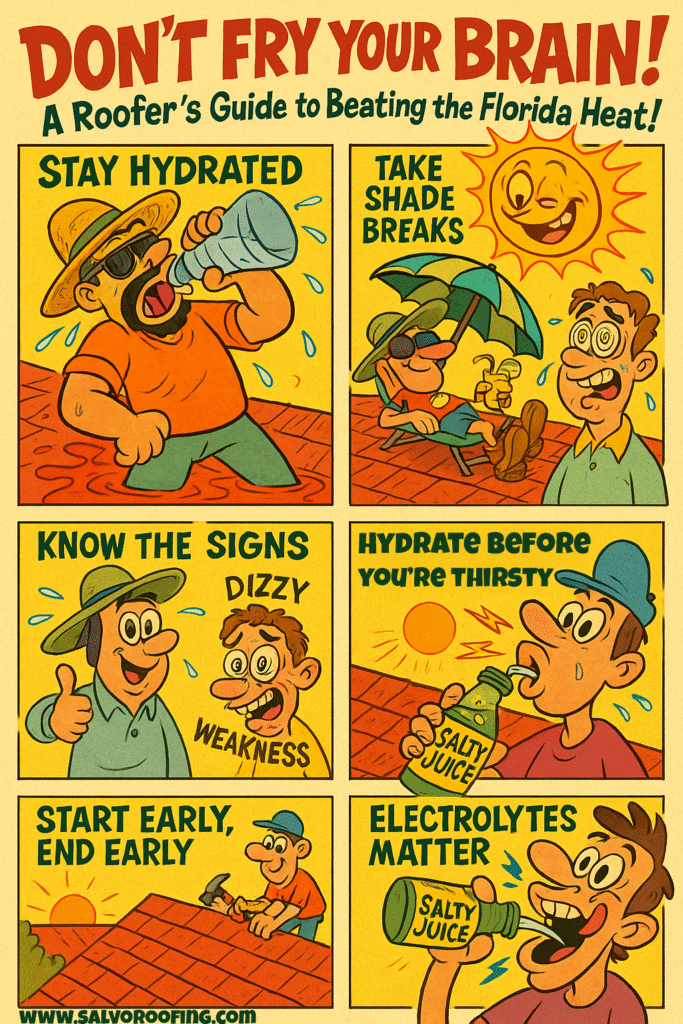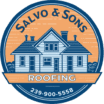
Introduction:
Roofing heat safety Florida isn’t just a topic for discussion—it’s a life-or-death reality for every roofer working on Southwest Florida roofs in the spring, summer, and fall. If you’ve spent even a single summer atop a roof in Cape Coral, Fort Myers, Naples, or Punta Gorda, you know the relentless combination of heat and humidity isn’t just uncomfortable—it can be dangerous, even deadly, if you’re not prepared. Roofing heat safety Florida is essential for your health.
From April through October, it’s common to see daily highs soar past 95°F , with humidity levels that leave you soaked in sweat within minutes. For roofers, contractors, and anyone working outside, this isn’t just a nuisance-it’s a health hazard that can cut productivity, cause serious medical emergencies, and even end careers.
Understanding roofing heat safety Florida can make a big difference in your work day. Ensure you take the necessary precautions.
Implementing roofing heat safety Florida guidelines can protect you from heat-related illnesses.
So how do we beat the Florida heat while getting the job done? At Salvo & Sons Roofing, we’ve made it our mission to keep our team safe and productive in the toughest conditions. Here’s our practical, roofer-tested guide-built around the six key rules in the featured image above-that will help you survive and thrive on the hottest roofs in Florida.
Incorporating roofing heat safety Florida into your daily routine is crucial for survival.
Roofing heat safety Florida requires constant attention to hydration.
1. Stay Hydrated

There’s a reason this tip is first: Hydration is everything when you’re roofing (or playing) in the sun. On a typical summer day in Southwest Florida, roof deck temperatures can easily exceed 120°F, and you can lose a quart or more of sweat per hour.
What happens when you don’t hydrate?
- Fatigue sets in quickly.
- Headaches, nausea, and muscle cramps follow.
- Performance drops, and mistakes go up.
- The risk of heat exhaustion and heat stroke skyrockets.
Best Practices for Roofers:
Prioritizing roofing heat safety Florida will enhance productivity and well-being.
- Drink before you’re thirsty. Thirst is a late sign of dehydration-by the time you feel it, you’re already behind.
- Start your day hydrated. Have at least 16-24 oz of water before your shift.
- Bring enough fluids. Plan for at least a gallon (128 oz) per person per 8-hour day. For multi-crew jobs, bring a cooler stocked with water and electrolyte drinks.
- Use refillable bottles or hydration packs. These make it easy to keep sipping, even with gloves or safety gear on.
Roofing Pro Tip:
Don’t rely on sugary sodas or high-caffeine energy drinks. Water is best for most of your fluid intake, but when sweating heavily, add in an electrolyte drink (more on this below).
2. Take Shade Breaks

Shade is a roofer’s best friend in the Florida summer. Even if you’re fit and experienced, constant exposure to direct sun will break you down. Taking regular breaks in the shade isn’t a sign of weakness-it’s smart jobsite management.
Why Shade Breaks Matter:
Regular breaks for roofing heat safety Florida can help you recover and stay alert.
- Even a 5-minute break in the shade can lower your core body temperature and help you recover.
- Shade breaks reduce the risk of heat-related illnesses and improve alertness.
- OSHA recommends frequent rest periods for all outdoor workers in high-heat conditions.
Utilizing roofing heat safety Florida practices keeps you and your crew safe.
How to Build Shade into Your Roofing Routine:
- Bring pop-up canopies to large jobsites if there are no natural shaded areas.
- Stagger breaks. Rotate team members so there’s always someone working, but everyone gets a chance to cool off.
- Set up a break schedule. For example: 10 minutes in the shade every hour, especially between 11am and 4pm, when UV index peaks.
- Hydrate while resting. Drink fluids during every break—don’t just sit down and scroll your phone.
Remember, roofing heat safety Florida is vital for successful job completion.
Extra Florida Roofing Tip:
Many SW Florida roofs are made with light-colored tile or metal that reflects sunlight. This means glare can be intense. A shaded rest area with sunglasses and cold drinks is a must.
3. Know the Signs: Dizziness, Weakness, Heat Illness

Roofers can’t afford to ignore the early warning signs of heat stress. Knowing these signs-and acting fast-can literally save a life.
What Are the Warning Signs?
- Mild dehydration: Thirst, dry mouth, less frequent urination.
- Heat exhaustion: Dizziness, headache, weakness, heavy sweating, muscle cramps, nausea, rapid pulse, cool and clammy skin.
- Heat stroke (medical emergency!): Hot, dry skin (or heavy sweating that stops), confusion, slurred speech, fainting, very high body temperature.
What To Do If You Notice the Signs:
- Stop working and get to shade or a cool area immediately.
- Drink water or an electrolyte drink.
- Loosen or remove excess clothing.
- Apply cool compresses to the skin or use a fan.
- Call 911 if there’s confusion, loss of consciousness, or if symptoms don’t improve quickly.
Training Your Crew:
- Make “heat illness signs” a regular part of your safety meetings.
- Post a simple chart in your trailer or truck.
- Empower everyone to speak up if they notice a coworker acting off.
Real-World Example:
At Salvo & Sons Roofing, we’ve seen even the toughest, most experienced roofers get hit hard by heat exhaustion-especially after a poor night’s sleep or when trying to “push through.” Prevention and fast action are critical.
Awareness of roofing heat safety Florida can prevent serious health issues.
4. Hydrate Before You’re Thirsty

Hydration isn’t just about what you drink-it’s when you drink. If you’re waiting until you feel parched, you’re already a step behind.
How to Stay Ahead of Thirst:
Employing roofing heat safety Florida knowledge can aid in effective decision-making.
- Start hydrating before your shift: Drink a big glass of water with breakfast.
- Set a timer: Every 20-30 minutes, take a few big gulps of water or electrolyte mix-even if you’re not thirsty.
- Pair water with food: Eating snacks high in water content (fruits like oranges, watermelon) can help, too.
- Avoid “chugging” large amounts at once: Steady sipping is best to avoid bloating or GI discomfort.
Sample Roofer Hydration Schedule:
- 6:30am: 16 oz water before arriving on site
- 7:00am: 8 oz water
- 7:30am: 8 oz electrolyte drink
- 8:00am and every 30 min: 6-8 oz water
Why It Matters in SW Florida:
- Humidity makes sweat evaporate slower, so you may not notice how much you’re losing.
- Starting early is critical-by the time the sun peaks, your body needs to be fully topped off.
5. Start Early, End Early

Ask any Florida roofer: The best work gets done before noon. With sunrise around 6:30am in summer, the smart crews are up and working before most people are awake.
Why Early Starts Work:
- Lower temps in the morning mean safer conditions and higher productivity.
- Materials are easier to handle-hot metal or tile can burn hands or even damage shoes/gloves by afternoon.
- Finishing before the day’s peak heat keeps everyone safer and makes job sites more efficient.
How to Schedule Roofing Crews:
- Shift start: 6:30-7:00am
- Midday break: Around 12:00-1:00pm (ideally, finishing heavy work by this time)
- Wrap up: Plan to be off the roof before 2:00-3:00pm when heat index peaks.
Bonus Benefits:
- Homeowners appreciate seeing your crew start early-it shows professionalism.
- Early starts also reduce the risk of afternoon thunderstorms, which are common in SW Florida summers.
6. Electrolytes Matter

While water is crucial, it’s not enough by itself during long, sweaty shifts. When you sweat, you lose salt, potassium, magnesium, and other electrolytes—essential for nerve, muscle, and heart function.
Signs You Need Electrolytes:
- Headaches, muscle cramps, weakness, confusion.
- Feeling “washed out” or not recovering after breaks.
Best Electrolyte Sources for Roofers:
- DIY Electrolyte Drink:
Make a roofer’s “salty juice” with water, a pinch of sea salt, a little sugar or honey, and a splash of 100% fruit juice (pineapple, orange, or lemon).
Or, use a sugar-free electrolyte powder and mix with a gallon of water. - Sports Drinks:
Gatorade and Powerade work, but watch for excess sugar. Choose lower-sugar versions when possible. - Electrolyte tablets or sticks:
Convenient to keep in the truck, easy to add to a water bottle.
Sample Roofer Electrolyte Mix:
- 1 gallon cold water
- 1/2 tsp sea salt
- 2 tbsp sugar or honey
- 8 oz fruit juice
- (optional: magnesium or potassium supplement)
How Salvo & Sons Roofing Stays Fueled:
We keep a cooler with pre-mixed electrolyte drinks on every job. Crew members are encouraged to refill often, especially after heavy sweating or if anyone feels off.
Conclusion: Take the Heat Seriously, Protect Your Crew, and Stay Safe
Roofing in Florida’s heat isn’t for the faint of heart. But with planning, teamwork, and the right hydration strategy, you can stay safe, productive, and strong—no matter how high the mercury climbs.
At Salvo & Sons Roofing, we believe that safety is the foundation for every successful job. If you’re a homeowner looking for a roofing contractor who takes care of their people (and your property!), give us a call. And if you’re a roofer, share this post with your crew—let’s keep everyone safe this summer!
For more detailed information and up-to-date guidelines on working safely in extreme heat, be sure to check out resources from both OSHA’s Water. Rest. Shade. Campaign and the CDC’s Heat-Related Illnesses page. These organizations provide valuable tips and best practices for staying safe on the job, whether you’re a roofer or working outdoors in any capacity. Your health and safety are always the top priority—don’t hesitate to learn more!
If you have questions about heat safety, or want to know more about our roofing services in Cape Coral, Fort Myers, Naples, and the rest of SW Florida, contact us here.
Adhering to roofing heat safety Florida protocols is essential for health on the job.
Make roofing heat safety Florida a priority to ensure longevity in your career.
For effective productivity, roofing heat safety Florida must be the focus.
Incorporate roofing heat safety Florida strategies into your daily practices.
Effective roofing heat safety Florida techniques can mitigate risks significantly.
Communicating roofing heat safety Florida practices ensures everyone’s well-being.
